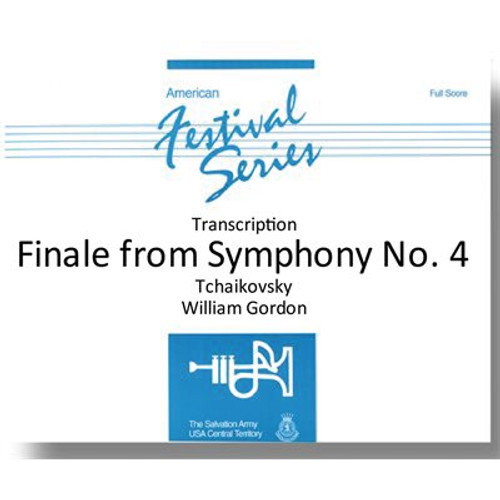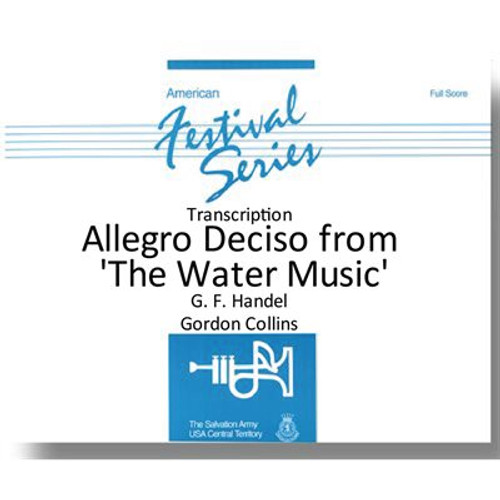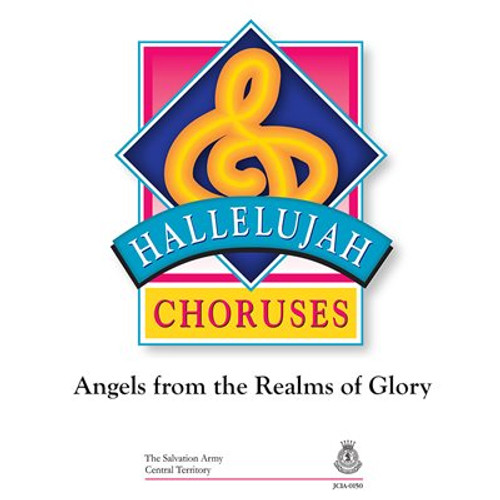Product Description
Finale from Symphony No. 4
Transcription
Composer: Tchaikovsky | Arranger: William Gordon
Produced by The Salvation Army - Central Territory
Score Sample
NotesThis is a digital product. After purchasing you'll be able to download it from Account -> Orders -> Select order number
Score Notes
Notes:
Beginning to bar 9: A measured, yet fiery tempo should be established from the outset, punctuated by percussion. Note that two percussion parts are provided. Percussion 1 is exclusively for timpani, while Percussion 2 includes essential parts for crash cymbals, bass drum and triangle. In the event that an additional percussionist is available, optional snare drum notations are included on the Percussion 2 part. At bar 9, the trombones emulate French horns with accented half notes in octaves. Trombones should move to the background by bar 10.
Bars 10-37: The main motif of this movement commences in flugel and baritones at bar 10, with its simple descending scale pattern. Throughout the piece, a slight stress should be given to appoggiaturas, like the one on the downbeat of bar 12. The basses should imitate the light pizzicato of cellos and basses. At first, this is in unison, but by bar 14 there are independent rhythms between the Eb and Bb basses which should dovetail together as a composite whole. The solo cornet and solo euphonium figuration, commencing at bar 11, should be light and controlled.
By bar 18, Tchaikovsky abandons the descending scale figures for an appoggiatura on the downbeat of each measure, accompanied by an increase in the frequency of the cornet and euphonium figuration. Build tension with the crescendo at bar 22 to give way to a balanced exchange of descending scales, climaxing in a return to the fiery opening at bar 30. Note that there are differences from the opening bars (compare bar 3 with bar 26), and in the insertion of orchestral trumpet and trombone eighthnote octaves in bars 30 and 34.
Bars 38-59: Commencing at bar 38, the downbeat accent across the entire ensemble is essential to the forward motion of the piece. At bar 46, there is a sudden drop in volume to mezzo piano (and a reduction of players) with a quick crescendo to an intense tutti section at bar 47. The crash cymbals are vital to the overall effect of this climactic section. Work for unified, measured dotted eighth and sixteenth patterns across the entire ensemble. The triplets introduced at bar 51 should be light and only mezzo forte in volume, giving way to full-bodied ascending third patterns from bar 56. There is no altering of tempo moving into bars 58-59 concluding with the two quick martellato chords followed by a sudden stop after the percussion shot on the ""and"" of beat four.
Bars 60-83: Following the grand pause, a contrast in style and tempo is called for at bar 60. The descending scalic motif is brought back, now with an altered articulation. There should be a subtle rise and fall in dynamics over the two-bar phrase. Give both length and space to the initial four eighth notes, and a light stress to the downbeat appoggiatura on the next bar. The accompanying chords should be very broad, yet never heavy.
Bars 84-109: At bar 84, an accelerando over four bars to the original tempo sets up an antiphonal exchange between the upper and lower parts of the band. The accented third beat half notes in trombones and 2nd cornet may sound almost as fortepiano chords. By bar 92, the exchanges of sixteenth notes have been telescoped closer together, expanding between octaves and must maintain steady tempo. From bar 92, make sure the exchange of quarter note chords in pairs are solidly accented. At bar 98, the descending scalic motif requires a more muscular approach, commencing in trombones and basses, answered in a similar bold fashion beginning at bar 101 by the upper portion of the band.
Bar 110-133: A rallentando leads to the dramatic statement from the opening of the first movement, marked at a slower Andante tempo at bar 110. The crash cymbal is essential and the chords underneath the horns and cornets ""trumpeting"" should be broad and sonorous. Note the sudden drop in volume to mezzo forte in bar 114, and the subsequent crescendo leading to the climactic chord, which includes full percussion at bar 116. The combination of horns, baritones and trombones seeks to emulate the orchestral horn section at bar 119 and following. Careful tuning between the octaves is required from bar 125 to the pianissimo transition into Tempo I at bar 134.
Bar 134-end: At bar 134, an extended timpani roll, commencing pianissimo, supports the quiet exchanges of the accented dotted pattern first introduced at bar 38. Keep a steady rhythm, while creating an exciting build-up. The dotted rhythms give way to antiphonal exchanges of eighth notes at bar 148, which need to preserve a steady pulse. A return of the antiphonal descending scales at bar 156 signals a reprise of the opening music at bar 160, this time with supporting ""trumpets and trombones"" in triplet rhythm. Maintaining tempo and rhythmic drive is paramount. This can be difficult, especially between bars 174 and 176, and as the band approaches the tutti syncopation at bar 177. Only the cymbal player and the conductor are on the beat through those two bars. Note the dramatic drop in volume to mezzo forte and subsequent crescendo at bar 186, as the band simultaneously accelerates into the quicker Vivace at bar 188. There is a subito mezzo forte at bar 192, which is followed by a crescendo. Also, maintain a controlled mezzo forte over bars 198-199 before the crescendo to the exciting concluding bars.
Program Note:
Tchaikovsky composed the fourth of his six symphonies in 1877, and it was premiered in 1878 in Moscow. The exciting Finale movement with its swirling scales, folk song-like motifs and extended crescendos remains an audience favorite. One high-point of the Finale is the dramatic reentry of the opening trumpet fanfare from the first movement, which subsides to a near standstill, and then ignites into the exciting conclusion. We are grateful to William Gordon for this fine transcription for brass band.
Program Note:
This colorful selection uses three songs of contrasting idiom to portray a progression of the human condition from despair to triumph:
Although this is a more extended work (approximate duration: 9:00), the inclusion of optional introductions and endings provides added usefulness of presenting singular performances of these three songs as follows:
Sometimes I feel like a motherless child: Beginning to optional ending at bars 39-40.
Reach out and touch: Bar 42 to optional ending at bars 110-113.
Storm the forts of darkness: Begin with snare drum roll (can be a pause) one beat before 117. Play to end as written.
Program Note:
This beautiful setting for solo trombones and band of the folk song O Waly, O Waly is often associated with the words of Isaac Watts:Note to the Conductor:
We are pleased to present this sensitive setting as it was initially conceived for solo trombone. Written for the Amsterdam Staff Band's 2005 tour of the United Kingdom, it was later adapted as a feature for trombone ensemble, at the request of Salvationist Publishing & Supplies, where it appears in 2009 as General Series 2059.
We are grateful to SP&S for kindly giving permission to publish this solo version in the American Festival Series. Of this work, the arranger, Olaf Ritman writes: "I consider this song my personal testimony."
Beginning to bar 12: The accompaniment, particularly at the opening and closing of the piece, is atmospheric, with suspended muted chords supporting the rubato trombone solo. The judicious use of percussion (chimes, bass drum and suspended cymbal) will add to the color and mood. Be sure to cue the chimes at bars 3 and 6.
at bar 4, a clear downbeat cure for the bass drum will help clarify tempo following the soloist's pause. Also give attention to the muted sforzando in cornets and trombones in bar 8.
Bars 13-52: Following the ritardando at bar 12, it is essential for the conductor to establish the correct tempo at bar 13, allowing the soloist lyrical freedom and the ability to sustain long phrases as the tune begins at bar 16. The descending scale gesture at bar 39 should be measured, yet not overstated.
Bars 53-74: There is a slight slowing of tempo as soprano, flugel and horns take the theme while cornets, trombones and euphonium adding countermelody.
Bars 75 to end: Returning to the opening tempo, it will again be helpful to give clear cues for the chimes, bass drum and triangle from bars 75 to the end.
[Note: This solo can be heard on the Chicago Staff Band recording,Kurios, performed by Brett Tolcher]
Program Note:
The tune Randolph, by preeminent English composer Ralph Vaughan Williams was first published in 1906 as a setting of Jeremiah Rankin's hymn, of which the first verse reads:
Note to the Conductor:
William Gordon's stunning four verse setting of Randolph progresses from the quiet simplicity of unison cornets and with each succeeding verse builds to a magnificent organ-like finale.
Gratitude is expressed to the publisher and copyright holder, Oxford University Press, for granting permission to publish this brass setting in the American Festival Series.
Beginning to bar 9: A ceremonial snare drum roll is the sole accompaniment to the cornets opening unison rendering of the tune.
Bar 10-17: The mellow instruments (flugel, horns, baritones and euphoniums) provide a beautiful change of color here with 2nd horn, baritones and euphonium seamlessly adding harmony.
Bars 18-26: A two beat snare and bass drum roll signals the entrance of the cornets and trombones in a more brilliant third verse setting. Here the bass trombone is essential (cued in Eb bass). Bring out the rising soprano cornet line from bar 22.
Bar 27 to end: A dramatic percussion roll precedes the "open pipes" organ like sounds of the final verse at bar 27. Be sure to observe the swell in bar 30, followed by a dramatic decrescendo before building to the final climatic chords. Avoid any tendency to overblow while striving for the full sonorities of this majestic finale.
[Note: this setting is especially effective when performed as a benediction "in the round" with players grouped by sections surrounding the audience.]









